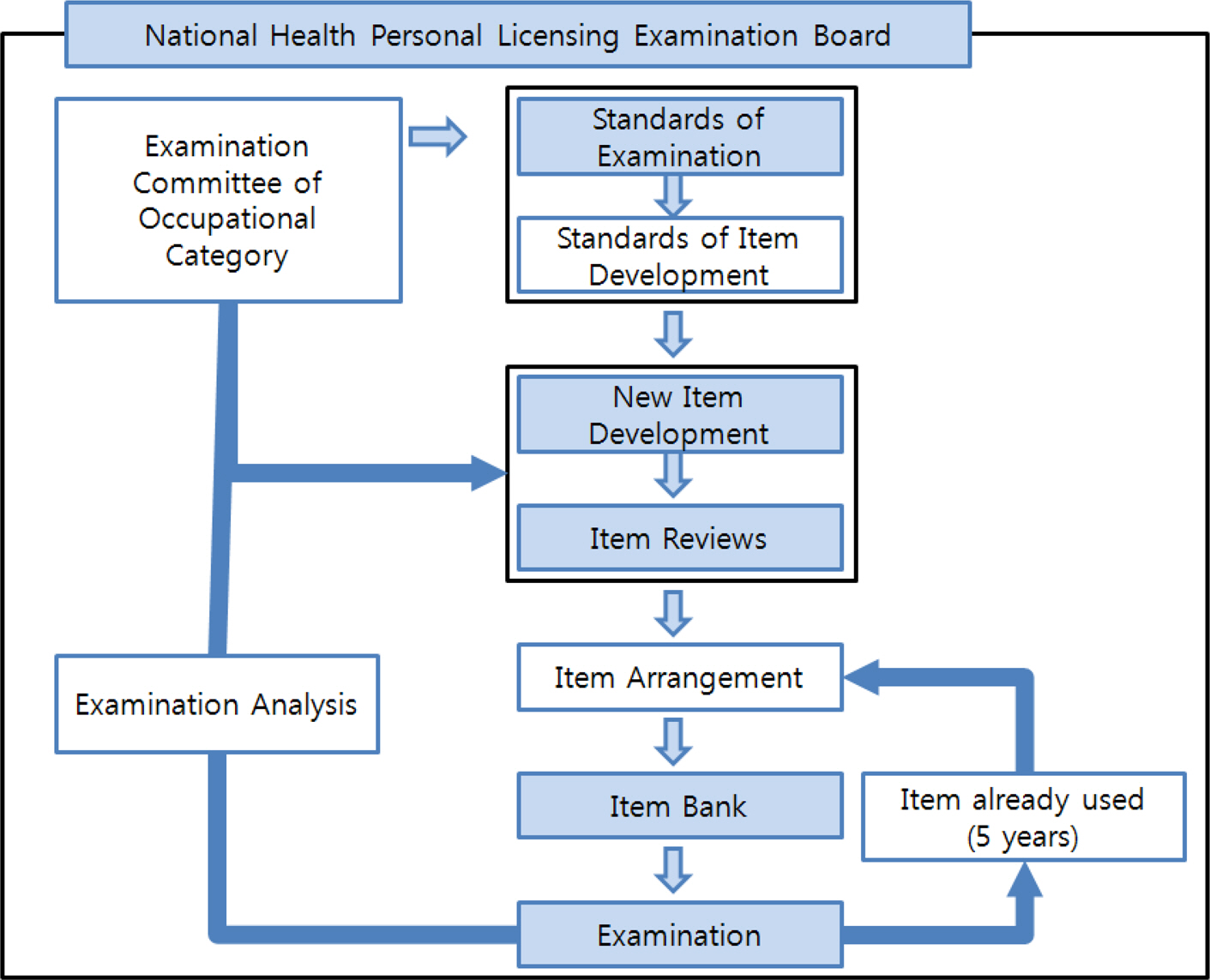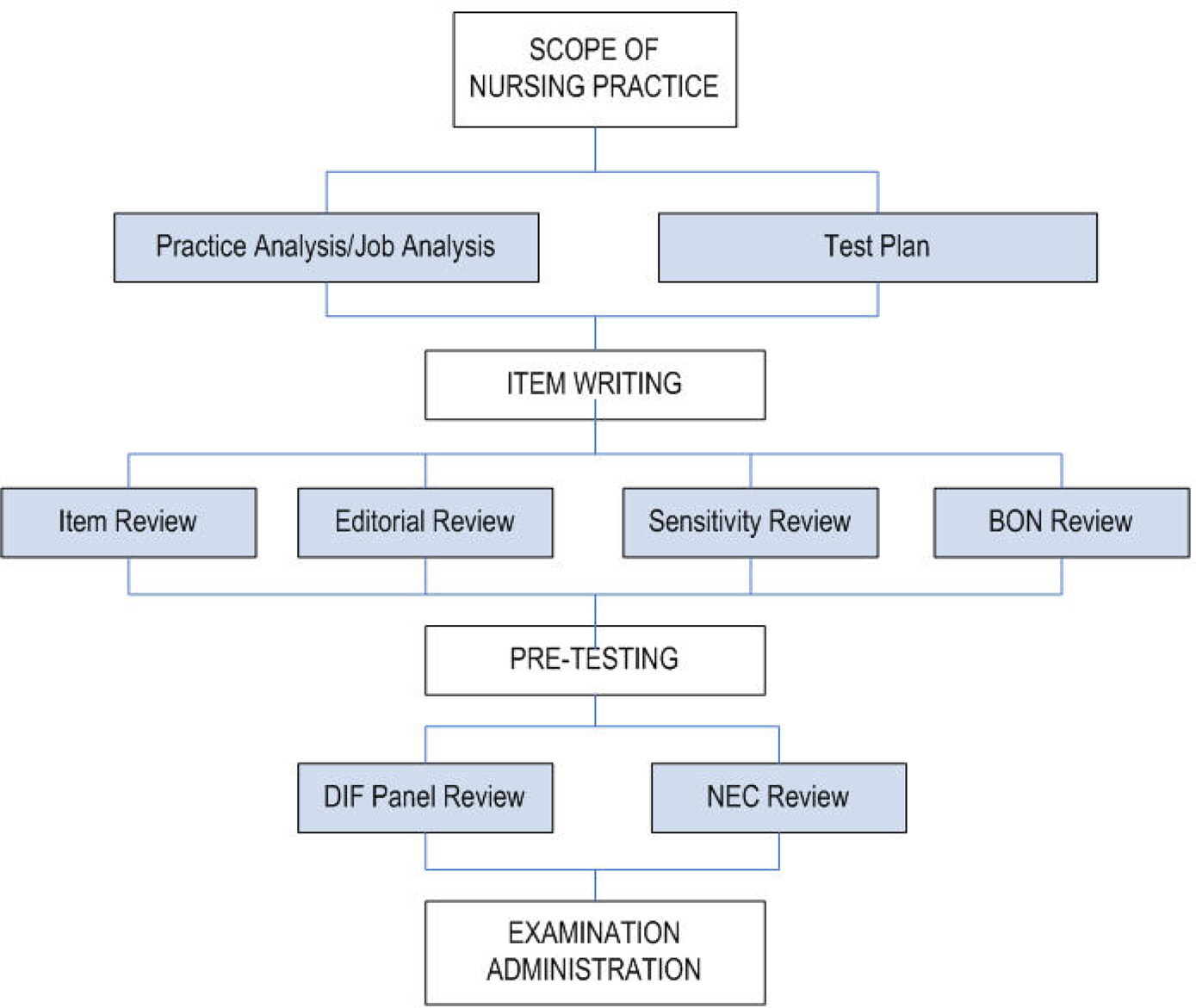1College of Nursing, Hallym University, Chuncheon
2College of Nursing, Seoul National University, Seoul, Korea
© 2012 Korean Society of Adult Nursing
This is an Open Access article distributed under the terms of the Creative Commons Attribution Non-Commercial License (http://creativecommons.org/licenses/by-nc/3.0/) which permits unrestricted non-commercial use, distribution, and reproduction in any medium, provided the original work is properly cited.




Interview Contents (N=5)
| Subject | Interviewees | Contents |
|---|---|---|
| NCBSN organization | The director and the department chair of NCSBN | ․ Who make a test plan initially? |
| ․ How to select categories of the test and devide each category proportionally? | ||
| ․ How to preform practice analyses? | ||
| ․ What are the required qualification for each panel and committee? | ||
| ․ What is the education and experience background for a judge on the panel? | ||
| ․ How collect practice items? | ||
| ․ Information about the item selection process? | ||
| ․ What are the standards applied to the item selection? | ||
| ․ Who and how to collect entry-level and general practices that are essential basic knowledge? | ||
| ․ Information about item development process: content review, item writing, editing, reviewing sensitivity and legal aspects | ||
| ․ How to predict item difficulty? | ||
| ․ How to decide pass and fail? | ||
| ․ Information about pre-test | ||
| ․ Process about item revision and elimination | ||
| NCLEX-RN item contents | Item developer and clinician | ․ How to become a representative of each state? |
| ․ Information about item formats, contents, and alternate formats, review process, and monitoring examinations | ||
| ․ How to analyze general and entry-level practice across nation-wide? | ||
| ․ How to determine if difference in group performance is relevant to nursing practice and/or plausible? |
Comparison of U.S. and Korea Nurse Licensure System
| Categories | U.S. | Korea |
|---|---|---|
| Institution | ․ NCLEX examinations are developed and owned by the NCSBN, non-profit organization, that manages examinations for registered and practice nurses only. | ․ The National Health Personnel Licensing Board (NHPLB) manages nurses' licensing examination including 21 other health related licensure examination. |
| ․ NCLEX is administered by the Pearson VUE in their network of Pearson Professional Centers | ||
| Board of directors | ․ NCSBN Delegate Assembly consists of 60 members from the boards of nursing in the 50 U.S. states and it's territories. | ․ Board members of the NHPLB consist of presidents of 21 other health related jobs who are in charge of 2 years usually. |
| ․ The director of NCSBN is in charge for 4~8 years. | ․ The director of NHPLB is in charge for 2~4 years. | |
| Test Item | ․ Safe and effective care environment | ․ Adult, maternity, pediatric, psychologic, community, and fundamental nursing |
| ․ Health promotion and maintenance | ․ Nursing management | |
| ․ Psychosocial integrity | ․ Legal scope of practice | |
| ․ Physiological integrity | ||
| Types of question | ․ Multiple response items | ․ Multiple response items only |
| ․ Fill-in blank items | ||
| ․ Hot spot items | ||
| ․ Chart/exhibit format | ||
| ․ Drag-and-drop items | ||
| ․ Audio item format | ||
| ․ Graphic format | ||
| Convenience of testing | ․ After receiving an authorization for testing from the Board of Nursing, a examinee can request a preferred date and time of testing at a preferred location. | ․ The paper-pencil exam is offered annually. Candidate should take it the at the designated date, time, and place |
| ․ If fail, the exam can be retaken anytime. The number of times a examinee can retake the exam is varied by States. | ․ If fail, a candidate should wait for one year to retake the exam. | |
| Efficiency of the test | ․ The NCLEX uses CAT system for maximum efficiency of the exam process. (high ability people few few easy items and low ability people get few difficulty items) | ․ Every examinee should solve 330 questions. |
| ․ It re-estimated the examinee's ability after every answer. | ||
| ․ The numer of items an examinee receives on their test depends upon their ability (minimum 75 to maximum 265 items) | ||
| Relevance to nursing practice | ․ Actively working nurses are initial item developers | ․ Nursing professors who teach students at the university level and do not participate in nursing practice are the item developer and reviewer. |
| Item review process items through three process year-round : | ․ Clinical nurses and educators together review | ․ There is no official review process. |
| ․ 1) Item review panel that reviews for job relatedness, accuracy, currency, and entry-level. | ||
| ․ 2) Editorial review that checks for clarity, grammar, punctuation, spelling | ||
| ․ 3) Sensitivity panel that reviews ethnocentrism and elitism, stereotypes, underlying assumptions, tone of language, inappropriate terminology. | ||
| Item difficulty | ․ All newly developed items undergo pre-testing prior to becoming operational. Through the pre-testing process, items are calibrated for item difficulty. This known item difficulty allow NCSBN to estimate a candidate's ability. | ․ There is no pre-testing process. Each item contains an equal level of difficulty |